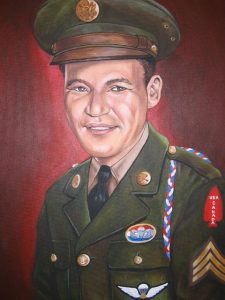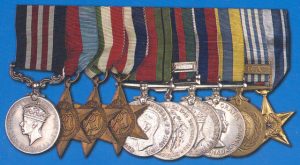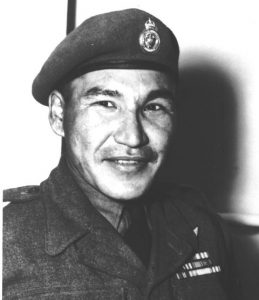


SGT. TOMMY PRINCE, MM, SS
Tommy Prince was the great great grandson of Chief Peguis, who led a band of Saulteaux from Sault Ste. Marie to St. Peters north of Selkirk, Manitoba around 1790. Tommy was born in Petersfield, Manitoba in October of 1915, one of eleven children.
Tommy enlisted in the 1st Corps Field Park Company of the Canadian Engineers on 3 June 1940. After six weeks of basic training, the unit sailed for England where he spent two years guarding military and civilian establishments. In 1942, Tommy Prince volunteered for the parachute training. He was one of only nine out of a hundred to gain his jump wings. He was promoted to the rank of Corporal. In September 1942 Tommy Prince flew back to Canada to join the Canadian Parachute Battalion that was then attached to the First Special Service Force, a joint Canada-US airborne unit which wore American Uniforms. The Force consisted of fully qualified paratroopers who were then given extensive and rigorous training as ski troops, mountain fighters, demolition specialists, and in hand to hand combat. It was reputed to be the best small fighting force ever assembled on the North American continent.
During the allied advance up the Italian peninsula, the 1st Special Service Force spent ninety days without relief at the Anzio beachhead. Tommy was a reconnaissance Sergeant and would reconnoiter enemy positions and relay information back. On 8 February 1944, on a lone volunteer assignment, Prince ran a telephone wire 1500 metres to an abandoned house behind the enemy lines under the cover of darkness. He established an observation post and reported back the exact positions of enemy emplacements to the Artillery. Four of the enemy positions had been destroyed when the line suddenly went dead. Prince guessed that a shell had cut the wire. Wearing some old farm clothes from the house, Prince went out into the field acting as an Italian peasant tending his farm. He followed the telephone line until he found the spot where it had been cut. He bent down pretending to tie his shoelaces and spliced the line. After succeeding in this task he continued to weed the field for a short time and then returned to the farmhouse and continued to report on the enemy. Soon, shaken by the intense and accurate artillery fire, the enemy pulled back. Only then did Prince report back to his Commanding Officer. Lieutenant Colonel Gilday recommended that Sgt. Prince be awarded the Military Medal for “exceptional bravery in the field”.
After the capture of Italy, the Force participated in the invasion of Southern France, working its way up the Riviera. The brigade had advanced until being held up by a natural mountainous defensive position. Tommy Prince, accompanied by a private, was sent to reconnoiter behind the enemy lines. He located the enemy encampment and after being involved in a firefight, returned to his own lines to report what he had found. Despite his fatigue, he was sent out at the head of the Battalion to lead a lightning attack on the German positions. By the time the battle had ended, Tommy Prince had covered 70 km on foot, fought in two battles and had been without sleep or food for 72 hours. Over a thousand enemy soldiers were captured during the battle. For his part in the battle, the Americans awarded Tommy the Silver Star.
After the battle of France was won, King George VI summoned Sergeant Thomas Prince to an investiture at Buckingham Palace where the King pinned the Military Medal on his chest, and then, on behalf of President Roosevelt, pinned on the Silver Star. It was a rare event for the King to present two medals at once. When the war ended in Europe Tommy returned to Canada and was honourably discharged on 15 June 1945.
Tommy again volunteered for service with the Princess Patricia’s Light Infantry on the outbreak of the Korean conflict. He again depended on his specialized training and experience by leading small force attacks into the enemy lines. After three months of fighting, the Patricia’s were sent back from the battle lines for a rest. The rest camp was in the Kapyong River valley near the village of Chongchon-ni. While they were there, the enemy launched a massive attack rolling over the poorly trained South Koreans. The offensive was fast approaching the Kapyong Gap held by forces from Canada, Australia and the United States. The attack raged on for days, with several major attacks being repulsed by bayonet charges from the Patricia’s. After a long and costly defensive battle, the American Air Force was able to complete an airdrop of ammunition and food to the gallant Canadians. For their determination and heroism, the Princess Patricia’s Light Infantry were awarded a Presidential Unit Citation. In the summer of 1952, Tommy applied for and was accepted for a second tour of duty in Korea, with the 3rd Battalion PPCLI. The battalion arrived in Korea in November of 1952 and Tommy Prince was back in the war. He was in his element leading patrol into and behind enemy lines. During one of these patrols Tommy was wounded in the knee and disengaged the patrol. Still, true to form, he carried one of his comrades to safety on his back. After a truce was signed the Patricia’s returned home to Canada. Tommy was discharged from the Army with a small pension on 28 October 1953.
The War Service Record of Sergeant Thomas G. Prince, MM, SS
Periods of Service:
3 June 1940 – 20 August 1945
14 August 1950 – 28 October 1953
Ranks:
Sapper 3 June 1940
Lance Corporal 22 February 1941
Sergeant 16 March 1943
Sergeant 14 August 1950
Units and Regiments:
1st Corps Field Park Company, Royal Canadian Engineers.
1st Canadian Parachute Battalion.
1st Canadian Special Service Battalion (Devil’s Brigade).
2nd Battalion, Princess Patricia’s Canadian Light Infantry.
3rd Battalion, Princess Patricia’s Canadian Light Infantry.
Theatres of Service:
Canada;
Britain;
United States of America;
Aleutian Islands;
Central Mediterranean Area;
Southern France;
Germany;
Korea.

